|

Spine width
To estimate spine width
for uncoated paper 80 g/m2 - page count should be multiplied by 0,05mm (round up to 1mm);
for uncoated paper 90 g/m2 - page count should be multiplied by 0,055mm (round up to 1mm);
for uncoated paper 70 g/m2 - page count should be multiplied by 0,045mm (round up to 1mm);
for uncoated paper 120 g/m2 - page count should be multiplied by 0,074mm (round up to 1mm);
for uncoated paper 150 g/m2 - page count should be multiplied by 0,0925mm (round up to 1mm);
for volume paper Ecco-Book Cream and White vol. 2.0, 70 g/m2 - page count should be multiplied by 0,0685mm (round up to 1mm);
for volume paper Ecco-Book Lux vol. 1.8, 90 g/m2 - page count should be multiplied by 0,078mm (round up to 1mm);
for volume paper Munken Print White and Cream vol. 1.5 90 g/m2 - page count should be multiplied by 0,0675mm (round up to 1mm);
for volume paper Munken Print White and Cream vol. 1.5 150 g/m2 - page count should be multiplied by 0,1125mm (round up to 1mm);
for coated paper matt and gloss 115 g/m2 - page count should be multiplied by 0,045mm (round up to 1mm);
for coated paper gloss 150 g/m2 - page count should be multiplied by 0,052mm (round up to 1mm);
for coated paper matt 150 g/m2 - page count should be multiplied by 0,06mm (round up to 1mm);
for coated paper matt and gloss 200 g/m2 - page count should be multiplied by 0,084mm (round up to 1mm);
Inkjet papers:
To estimate spine width
for JetStar uncoated paper 80 g/m2 - page count should be multiplied by 0,05mm (round up to 1mm);
for volume paper Alto vol. 1.5 90 g/m2 - page count should be multiplied by 0,0675mm (round up to 1mm);
for volume paper Bio Top 3 vol. 1.35 90 g/m2 - page count should be multiplied by 0,06075mm (round up to 1mm);
for volume paper Munken Print Cream vol. 1.5 90 g/m2 - page count should be multiplied by 0,0675mm (round up to 1mm);
Example: Our Book has 250 pages printed on uncoated paper 80 g/m2, spine width = 250 x 0,05mm = 12,5mm ~ 13mm
Preparing cover for A4 size (210mm x 297mm)
horizontal length: 210mm x 2 + spine + 6mm bleed = 426mm + spine;
vertical length: 297mm + 6mm bleed = 303mm
Preparing cover for A5 size (148mm x 210mm)
horizontal length: 148mm x 2 + spine + 6mm bleed = 302mm + spine;
vertical length: 210mm + 6mm bleed = 216mm
Preparing cover for B5 size (170mm x 240mm)
horizontal length: 170mm x 2 + spine + 6mm bleed = 346mm + spine;
vertical length: 240mm + 6mm bleed = 246mm
There is no bleed required for black&white pages
7 mm margins is required.

Note: Do not put any text on books spine thinner then 6mm
Lines
Minimal line thickness is 0,25p (0,088mm)
Fonts
Minimal font size is 4p
All fonts in text should be converted to curves or embedded with the pdf file.
Background
Minimum colour use is 5% of any component (i.e.: C-0 M-0 Y-0 K-5)
Full blackness is achieved by using only black component (C-0 M-0 Y-0 K-100), no need to use other components
Colour - only CMYK scale in every graphic project. If you want to use spot colours (Pantone, HKS, etc.) you should look for adequate CMYK representation.
Gradients
Gradients shouldn't be less then 5% of tonal transition.
Resolution
Pictures and graphics should have 300DPI resolution and CMYK colour space (SWOP Coated CMYK)
Files
Prefered file format is PDF. Other file formats are accpeted but we will charge additional fee for converting.
Accepted file formats:
CDR CorelDraw ver. 11, fonts converted to curves, CMYK
JPG resolution 300 DPI, maximum quality, CMYK
All files should be added with no layers or transparencies (flattened)
Book Edge Printing (CMYK)This technique involves applying pigment inks to the edges of the book block paper. It is done in CMYK. The process enables printing themes, captions and graphics that can function as an extension of the cover illustration or supplement it. We also provide edge printing on books with rounded block corners.
Technical information:
- the ink may flow slightly between the sheets during printing,
- maximum book format: 210 x 297 mm (A4),
- maximum print width: 290 mm,
- minimum block thickness: from 1 mm,
- Pantone or other special colours will be converted to CMYK,
- the colours used on the book's edges should be similar to avoid soiling.
File preparation:
- IMPORTANT: edge's graphic designs should be prepared in vertical format,
- files must be in .pdf format (we recommend PDF/X-4:2010),
- graphic design format must include bleeds of 3 mm on each side,
- acceptable design resolution: 300 DPI,
- a separate file is required for each edge of the block to be printed (X1, X2, X3),
- files should be named as follows: X1_name_top.pdf, X2_name_front.pdf, X3_name_bottom.pdf,
- please attach a preview file with the positioning of the graphics according to the following example for your order:
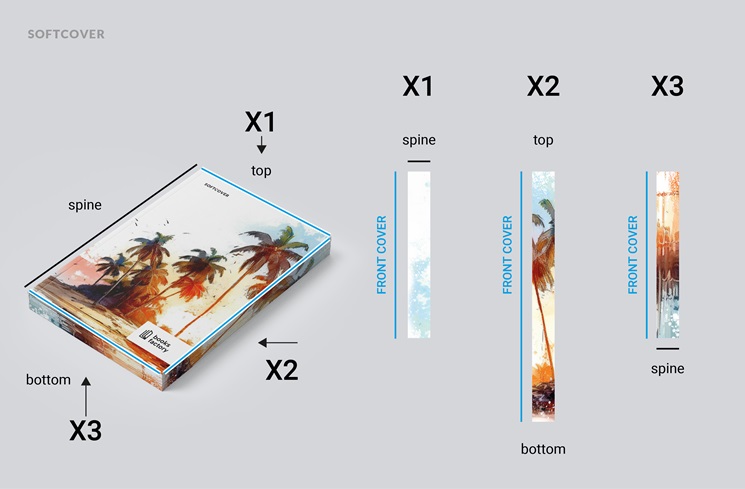
for several books (e.g. a trilogy) with split graphics, please prepare a shared file for each edge of the block.
Each file should contain the whole print design for that part of the graphic so that the books when standing side by side, form a coherent whole.
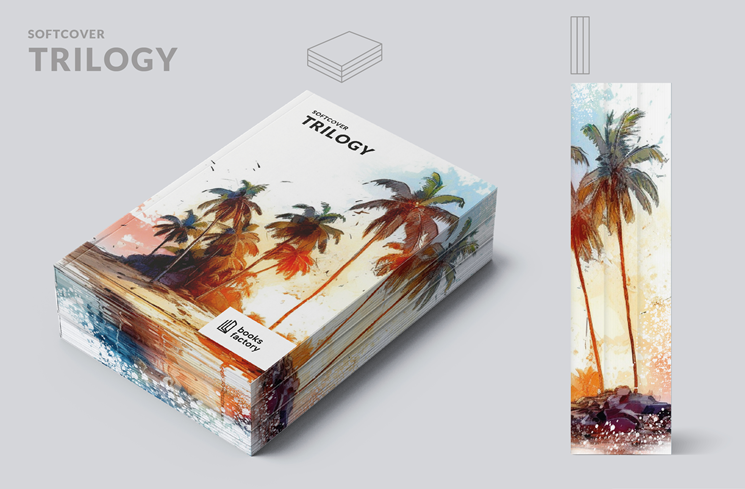
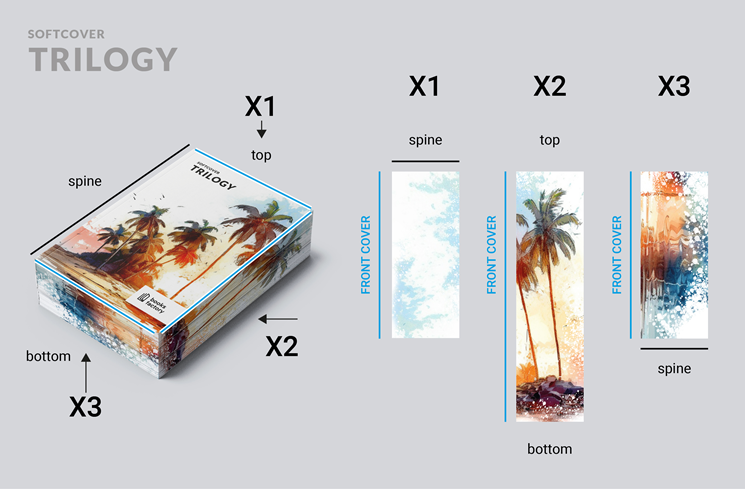
Risks and known problems:
- book edge printing does not cover the glueing,
- for technological reasons, minor ink drips may occur into the book block,
- a small quantity of the print run may be trimmed by 0.7 mm on the edges of the book block,
- printing in a solid colour is not recommended.
Die-cut window in the coverA die-cut window in a softcover is a hole made through all its layers. It can be located on the front, back, or on both sides of the book. In a softcover, it reveals either the first or last page. It is typically cut at a 90-degree angle (standard) relative to the cover. There are virtually no limitations on the shapes of die-cut windows. You need to prepare a mask similar to a UV varnish mask. In the mask, indicate the windows' appearance, number, and locations.
File preparation:
- the mask file should be prepared as a .pdf. The recommended standard is PDF/X-4:2010,
- the cut-out shape must be a vector – preferably a fill, not an outline,
- you should submit a PDF file containing three pages: the print cover, the print cover with the shape to be cut out
(position preview), and the cut-out mask (without cover):
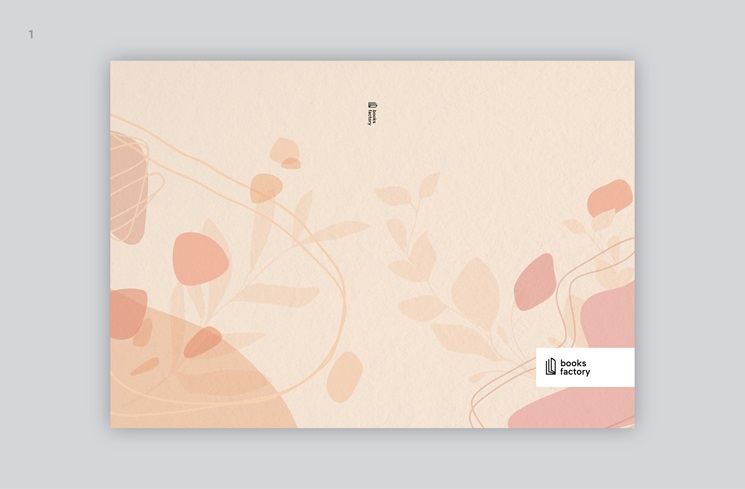
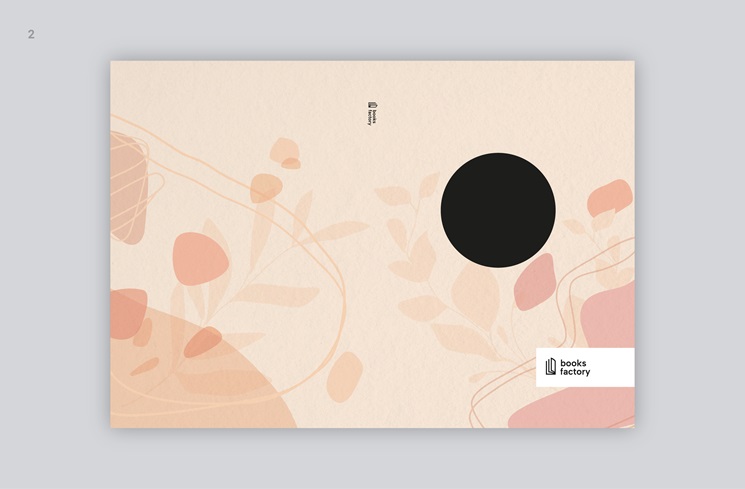
Technical notes:
- the safe cutting margins are 10 mm from the spine and 10 mm from the bottom edges:
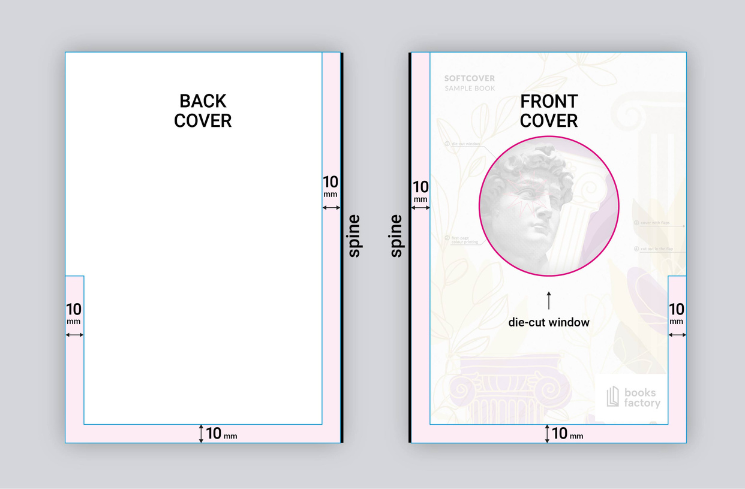
- it's possible to interrupt the edges of the cover. However, any openings must not extend into the lower half of the cover's outline,
and must maintain a minimum safety margin of 10 mm:
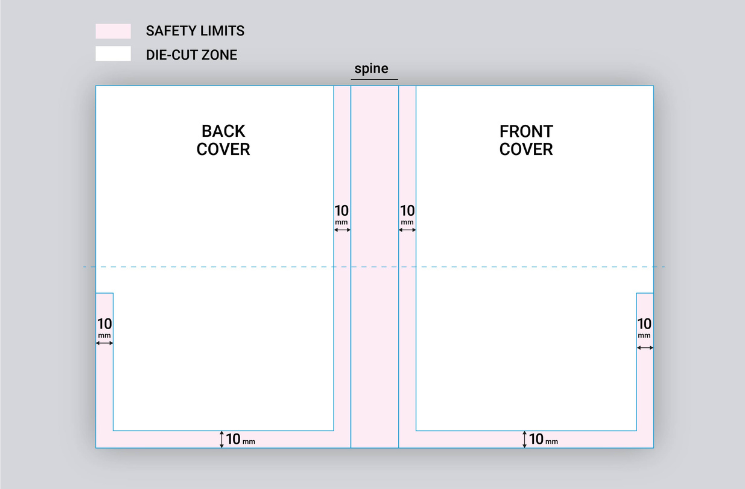
- cutting is possible for books with a maximum thickness of 50 mm,
- remember to design the first or last page of the block, which will become visible after the window in the cover is cut,
- the tolerance for the misalignment of objects between the cover and endpapers is up to 2 mm,
- we do not recommend, for example, inserting lines in the design which are to be continued on the part visible in the window.
Technical limitations for standard cuts in softcover (90 deg.):
- None. The DTP department can contact the client in case of highly complex projects.
We would be happy to give an opinion on the shape of your die-cut window if its specification goes beyond the above technical requirements.
|